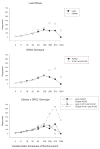Food reinforcement, the dopamine D2 receptor genotype, and energy intake in obese and nonobese humans
- PMID: 17907820
- PMCID: PMC2213752
- DOI: 10.1037/0735-7044.121.5.877
Food reinforcement, the dopamine D2 receptor genotype, and energy intake in obese and nonobese humans
Erratum in
- Behav Neurosci. 2008 Feb;122(1):250
Abstract
The authors measured food reinforcement, polymorphisms of the dopamine D2 receptor (DRD2) and dopamine transporter (DAT1) genes, and laboratory energy intake in 29 obese and 45 nonobese humans 18-40 years old. Food reinforcement was greater in obese than in nonobese individuals, especially in obese individuals with the TaqI A1 allele. Energy intake was greater for individuals high in food reinforcement and greatest in those high in food reinforcement with the TaqI A1 allele. No effect of the DAT1 genotype was observed. These data show that individual differences in food reinforcement may be important for obesity and that the DRD2 genotype may interact with food reinforcement to influence energy intake.
(PsycINFO Database Record (c) 2007 APA, all rights reserved).
Figures


References
-
- Adler CM, Elman I, Weisenfeld N, Kestler L, Pickar D, Breier A. Effects of acute metabolic stress on striatal dopamine release in healthy volunteers. Neuropsychopharmacology. 2000;22:545–550. - PubMed
-
- Bahk JY, Li S, Park MS, Kim MO. Dopamine D1 and D2 receptor mRNA up-regulation in the caudate-putamen and nucleus accumbens of rat brains by smoking. Progress in Neuropsychopharma-cology and Biological Psychiatry. 2002;26:1095–1104. - PubMed
-
- Bickel WK, Madden GJ, Petry NM. The price of change: The behavioral economics of drug dependence. Behavior Therapy. 1998;29:545–565.
-
- Bickel WK, Marsch LA, Carroll ME. Deconstructing relative reinforcing efficacy and situating the measures of pharmacological reinforcement with behavioral economics: A theoretical proposal. Psychopharmacology. 2000;153:44–56. - PubMed
-
- Bryant-Waugh RJ, Cooper PJ, Taylor CL, Lask BD. The use of the eating disorder examination with children: A pilot study. International Journal of Eating Disorders. 1996;19:391–397. - PubMed

